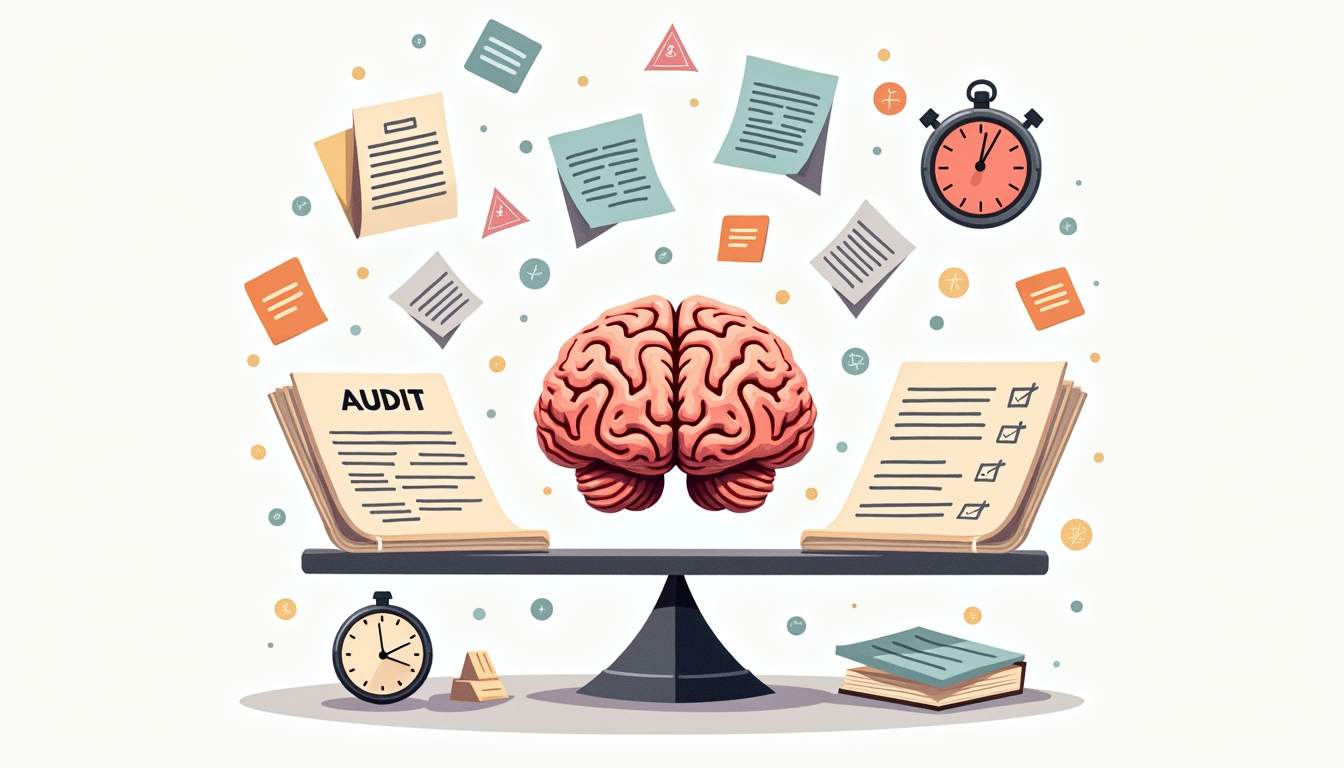Let’s face it – the life of an auditor isn’t exactly what most people would call “thrilling.” But what it lacks in Hollywood glamour, it makes up for in high-stakes pressure. Between poring over financial statements, checking compliance boxes, and racing against tight deadlines, maintaining focus isn’t just helpful – it’s absolutely essential. One small error could lead to major compliance issues or missed fraud indicators. So how do successful auditors stay sharp when the numbers start swimming before their eyes? Let’s dive into some practical focus strategies that can help you maintain accuracy while meeting those seemingly impossible deadlines.
Understanding the Auditor’s Focus Challenge
Auditing requires a unique type of concentration. You’re not just focusing on a single task – you’re simultaneously analyzing data, comparing it against standards, maintaining professional skepticism, and documenting everything meticulously. All while the clock is ticking loudly in your ear.

The human brain isn’t naturally wired for this kind of sustained analytical focus. Our ancestors needed to spot predators and find food, not reconcile accounts or test internal controls for eight hours straight. This disconnect between our evolutionary wiring and modern audit requirements creates the perfect storm for focus issues.
The Cost of Distraction in Audit Work
When your attention slips during an audit, the consequences can be serious. A misplaced decimal point, an overlooked discrepancy, or a skipped verification step can undermine the entire audit process. Research suggests that after an interruption, it takes an average of 23 minutes to fully return to the original task. In audit terms, that’s a lot of billable hours lost to mental transitions.
Beyond the time cost, there’s also the accuracy factor. Each time you switch contexts, you increase the likelihood of errors. For auditors working with complex financial data, these errors can cascade into significant misstatements or compliance failures.
Time Management Techniques for Auditors
The Pomodoro Technique: An Auditor’s Best Friend
One of the most effective focus methods for auditors is the Pomodoro Technique. This approach involves working in focused 25-minute intervals (called “Pomodoros”), followed by short 5-minute breaks. After completing four Pomodoros, you take a longer break of 15-30 minutes. This structured approach works particularly well for audit tasks because it creates natural checkpoints to verify your work.
The Focus Keeper app has become popular among auditors for implementing this technique. It offers customizable work intervals, tracks your focus sessions, and provides helpful analytics on your productivity patterns. Many auditors find that using Focus Keeper helps them maintain concentration during complex analytical procedures while preventing the mental fatigue that leads to errors.
Strategic Task Batching
Another effective approach is batching similar audit tasks together. For example, dedicate specific time blocks to:
- Document review and verification
- Client communications and follow-ups
- Complex analytical procedures
- Documentation and workpaper preparation
This minimizes the mental switching costs between different types of tasks. Your brain can settle into a particular mode of thinking rather than constantly recalibrating. During busy season, many auditors find that batching administrative tasks to the beginning or end of the day preserves their peak mental hours for the most demanding analytical work.
Time Blocking for Compliance Deadlines
When facing strict regulatory deadlines, time blocking becomes crucial. This involves scheduling specific blocks in your calendar for each component of the audit process, working backward from the deadline. The key difference between basic scheduling and effective time blocking is building in buffer zones – those extra pockets of time that account for the inevitable complications that arise during any audit.
For example, if you need to complete a SOX compliance audit by the end of the month, you might block out time like this:
- Days 1-5: Initial testing and documentation review
- Days 6-10: Control testing and evidence gathering
- Days 11-15: Deficiency evaluation and remediation discussions
- Days 16-20: Documentation completion and initial review
- Days 21-25: Final review and adjustments
- Days 26-30: Buffer time for unexpected issues
Environmental Optimization for Audit Focus
Your physical environment significantly impacts your ability to maintain focus during detailed audit work. Small adjustments can yield substantial improvements in concentration and accuracy.

Creating a Distraction-Free Workspace
Whether you’re at a client site, in your firm’s office, or working remotely, establishing boundaries around your workspace is essential. This might mean using noise-canceling headphones, setting up a “do not disturb” signal for colleagues, or creating a dedicated home office space that’s separate from living areas.
Many auditors find that using Focus Keeper’s visual timer serves as a signal to others that they’re in a deep work session. The visible countdown creates both a personal commitment to stay focused and a subtle message to colleagues that interruptions should wait until the timer ends.
Cognitive Strategies for Maintaining Audit Accuracy
The Two-Pass Review Method
One cognitive technique that’s particularly effective for maintaining audit accuracy is the two-pass review method. Instead of trying to catch everything in a single review, you intentionally look for different types of issues in separate passes:

- First pass: Focus on the big picture – do the numbers make sense in context? Are there unusual patterns or relationships?
- Second pass: Examine the details – check calculations, trace samples to source documents, verify compliance with specific requirements.
This approach works because it aligns with how our brains naturally process information, moving from general patterns to specific details. It helps prevent the common audit error of getting lost in minutiae while missing significant anomalies.
Mindfulness Practices for Auditors
It might sound a bit woo-woo for the accounting world, but mindfulness techniques have been shown to significantly improve focus and reduce errors in detail-oriented professions. Simple practices like taking three deep breaths before beginning a new workpaper or doing a quick body scan to release tension can reset your attention.
The Focus Keeper app incorporates mindful breathing exercises into its break periods, helping auditors quickly reset between focus sessions. These micro-breaks prevent the mental fatigue that often leads to overlooked details or compliance missteps.
Technology Tools for Enhanced Audit Focus
Beyond Focus Keeper, several other technological tools can help auditors maintain concentration and meet deadlines. Audit-specific software with built-in validation checks provides an additional layer of error prevention. Document management systems that organize workpapers logically reduce the cognitive load of searching for information.
The key is finding tools that reduce administrative friction without adding complexity. Each app or software should earn its place in your workflow by demonstrating a clear benefit to either focus quality or time efficiency.
At the end of the day, maintaining focus as an auditor isn’t just about personal productivity – it’s about professional integrity. The strategies outlined here aren’t merely nice-to-have techniques; they’re essential practices for meeting the exacting standards our profession demands. By implementing structured focus methods, optimizing your environment, and leveraging appropriate technology, you can maintain the sharp attention to detail that distinguishes truly exceptional audit work.





